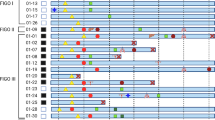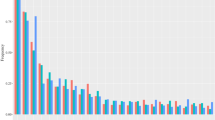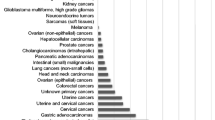Abstract
Somatic mutations of PIK3CA and ARID1A are the most common genetic alterations observed in ovarian clear cell adenocarcinomas (CCA). In a previous report, we showed that PIK3CA gene mutations and loss of ARID1A expression occur early during the development of CCA. In the present study, using direct genomic DNA sequencing for exons 9 and 20 of PIK3CA and immunohistochemistry for ARID1A protein expression, we analyzed the association of these molecular alterations with various clinicopathological parameters in a total of 90 cases of primary ovarian CCA, including 42 previously examined cases. The presence of PIK3CA mutations, identified in 34 (39%) of the 88 informative cases, was significantly associated with a grossly cystic tumor, the presence of adjacent endometriosis, prominent papillary architecture of tumor growth, the presence of hyalinized and mucoid stroma, and the absence of clear cell adenofibroma components (P < 0.05, each). There was no significant association of PIK3CA mutations with other clinical variables, such as age, clinical stage, or clinical outcome of the patients. The intensity of immunoreactivity for ARID1A was assigned as negative, weakly positive, and strongly positive in 44%, 22%, and 33% of tumors, respectively. Compared to tumors immunoreactive for ARID1A, ARID1A-negative tumors were significantly associated with the presence of adjacent endometriosis (P = 0.025), but there was no statistically supported association with other examined clinicopathological parameters. Compared with CCAs strongly positive for ARID1A, CCAs negative for ARID1A more frequently harbor PIK3CA mutations (P = 0.013). PIK3CA gene mutations and ARID1A immunohistochemistry lacked prognostic significance. These data further support the idea that these molecular alterations occur as very early events during tumor development of ovarian CCA.




Similar content being viewed by others
References
Lee KR, Tavassoli FA, Part J et al (2003) Surface epithelial-stromal tumours. In: Tavassoli FA, Devilee P (eds) World Health Organization classification of tumours. Pathology and genetics of tumours of the breast and female genital organs. IARC, Lyon, pp 117–145
Chan JK, Teoh D, Hu JM et al (2008) Do clear cell ovarian carcinomas have poorer prognosis compared to other epithelial cell types? A study of 1411 clear cell ovarian cancers. Gynecol Oncol 109:370–376
Mizuno M, Kikkawa F, Shibata K et al (2006) Long-term follow-up and prognostic factor analysis in clear cell adenocarcinoma of the ovary. J Surg Oncol 94:138–143
Takano M, Kikuchi Y, Yaegashi N et al (2006) Clear cell carcinoma of the ovary: a retrospective multicentre experience of 254 patients with complete surgical staging. Br J Cancer 94:1369–1374
Kuo KT, Mao TL, Jones S et al (2009) Frequent activating mutations of PIK3CA in ovarian clear cell carcinoma. Am J Pathol 174:1597–1601
Yamamoto S, Tsuda H, Takano M et al (2011) PIK3CA mutation is an early event in the development of endometriosis-associated ovarian clear cell adenocarcinoma. J Pathol 225:189–194
Wiegand KC, Shah SP, Al-Agha OM et al (2010) ARID1A mutations in endometriosis-associated ovarian carcinomas. N Engl J Med 363:1532–1543
Jones S, Wang TL, Shih I et al (2010) Frequent mutations of chromatin remodeling gene ARID1A in ovarian clear cell carcinoma. Science 330:228–231
Stokoe D, Stephens LR, Copeland T et al (1997) Dual role of phosphatidylinositol-3,4,5-trisphosphate in the activation of protein kinase B. Science 277:567–570
Shayesteh L, Lu Y, Kuo WL et al (1999) PIK3CA is implicated as an oncogene in ovarian cancer. Nat Genet 21:99–102
Samuels Y, Wang Z, Bardelli A et al (2004) High frequency of mutations of the PIK3CA gene in human cancers. Science 304:554
Kang S, Bader AG, Vogt PK (2005) Phosphatidylinositol 3-kinase mutations identified in human cancer are oncogenic. Proc Natl Acad Sci USA 102:802–807
Broderick DK, Di C, Parrett TJ et al (2004) Mutations of PIK3CA in anaplastic oligodendrogliomas, high-grade astrocytomas, and medulloblastomas. Cancer Res 64:5048–5050
Lee JW, Soung YH, Kim SY et al (2005) PIK3CA gene is frequently mutated in breast carcinomas and hepatocellular carcinomas. Oncogene 24:1477–1480
Velho S, Oliveira C, Ferreira A et al (2005) The prevalence of PIK3CA mutations in gastric and colon cancer. Eur J Cancer 41:1649–1654
Hayes MP, Wang H, Espinal-Witter R et al (2006) PIK3CA and PTEN mutations in uterine endometrioid carcinoma and complex atypical hyperplasia. Clin Cancer Res 12:5932–5935
Ogino S, Nosho K, Kirkner GJ et al (2009) PIK3CA mutation is associated with poor prognosis among patients with curatively resected colon cancer. J Clin Oncol 27:1477–1484
Sartore-Bianchi A, Martini M, Molinari F et al (2009) PIK3CA mutations in colorectal cancer are associated with clinical resistance to EGFR-targeted monoclonal antibodies. Cancer Res 69:1851–1857
Isakoff SJ, Engelman JA, Irie HY et al (2005) Breast cancer-associated PIK3CA mutations are oncogenic in mammary epithelial cells. Cancer Res 65:10992–11000
Reisman D, Glaros S, Thompson EA (2009) The SWI/SNF complex and cancer. Oncogene 28:1653–1668
Sif S, Saurin AJ, Imbalzano AN et al (2001) Purification and characterization of mSin3A-containing Brg1 and hBrm chromatin remodeling complexes. Genes Dev 15:603–618
Wang W, Xue Y, Zhou S et al (1996) Diversity and specialization of mammalian SWI/SNF complexes. Genes Dev 10:2117–2130
Ho L, Crabtree GR (2010) Chromatin remodelling during development. Nature 463:474–484
Yamamoto S, Tsuda H, Takano M, et al (2011) Loss of ARID1A protein expression occurs as an early event in ovarian clear-cell carcinoma development and frequently coexists with PIK3CA mutations. Mod Pathol (in press)
Maeda D, Mao TL, Fukayama M et al (2010) Clinicopathological significance of loss of ARID1A immunoreactivity in ovarian clear cell carcinoma. Int J Mol Sci 11:5120–5128
Yamamoto S, Tsuda H, Takano M et al (2008) Expression of platelet-derived growth factors and their receptors in ovarian clear-cell carcinoma and its putative precursors. Mod Pathol 21:115–124
Yamamoto S, Tsuda H, Miyai K et al (2010) Cumulative alterations of p27-related cell-cycle regulators in the development of endometriosis-associated ovarian clear cell adenocarcinoma. Histopathology 56:740–749
Yamamoto S, Tsuda H, Takano M et al (2008) Clear-cell adenofibroma can be a clonal precursor for clear-cell adenocarcinoma of the ovary: a possible alternative ovarian clear-cell carcinogenic pathway. J Pathol 216:103–110
Kato N, Takeda J, Fukase M et al (2010) Alternate mucoid and hyalinized stroma in clear cell carcinoma of the ovary: manifestation of serial stromal remodeling. Mod Pathol 23:881–888
Therasse P, Arbuck SG, Eisenhauer EA et al (2000) New guidelines to evaluate the response to treatment in solid tumors. European Organization for Research and Treatment of Cancer, National Cancer Institute of the United States, National Cancer Institute of Canada. J Natl Cancer Inst 92:205–216
Guan B, Mao TL, Panuganti PK et al (2011) Mutation and loss of expression of ARID1A in uterine low-grade endometrioid carcinoma. Am J Surg Pathol 35:625–632
Veras E, Mao TL, Ayhan A et al (2009) Cystic and adenofibromatous clear cell carcinomas of the ovary: distinctive tumors that differ in their pathogenesis and behavior: a clinicopathologic analysis of 122 cases. Am J Surg Pathol 33:844–853
Yamamoto S, Tsuda H, Yoshikawa T et al (2007) Clear cell adenocarcinoma associated with clear cell adenofibromatous components: a subgroup of ovarian clear cell adenocarcinoma with distinct clinicopathologic characteristics. Am J Surg Pathol 31:999–1006
Acknowledgments
This work was supported in part by a grant-in-aid for promotion of defense medicine from the Ministry of Defense, Japan (S.Y., O.M.), by a grant-in-aid for cancer research from the Ministry of Health, Labor, and Welfare, Japan (H.T.), and by a grant from the Foundation for Promotion of Cancer Research (S.Y. and H.T.). We are grateful to Ms. Kozue Suzuki, Department of Basic Pathology, National Defense Medical College, Saitama, Japan, for her technical assistance.
Conflicts of interest
The authors declare no actual or potential conflicts of interest associated with this study.
Author information
Authors and Affiliations
Corresponding author
Rights and permissions
About this article
Cite this article
Yamamoto, S., Tsuda, H., Takano, M. et al. PIK3CA mutations and loss of ARID1A protein expression are early events in the development of cystic ovarian clear cell adenocarcinoma. Virchows Arch 460, 77–87 (2012). https://doi.org/10.1007/s00428-011-1169-8
Received:
Revised:
Accepted:
Published:
Issue Date:
DOI: https://doi.org/10.1007/s00428-011-1169-8




